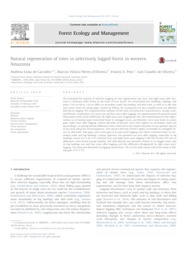Natural regeneration of trees in selectively logged forest in western Amazonia.
Natural regeneration of trees in selectively logged forest in western Amazonia.
Author(s): CARVALHO, A. L. de; OLIVEIRA, M. V. N. d'; PUTZ, F. E.; OLIVEIRA, L. C. de
Summary: We evaluated the impacts of selective logging on tree regeneration one, four, and eight years after harvests in Antimary State Forest in the State of Acre, Brazil. We inventoried tree seedlings, saplings, and poles (>50 cm tall to <10 cm DBH) on secondary roads, log landing, and skid trails, as well as in the bole and crown zones of canopy gaps created by felling; for comparison we also sampled areas not affected directly by logging. We compared these habitats on the basis soil (physical) characteristics, canopy cover, and floristic composition. For areas one and four years after logging, we supplemented the ground-based information with aerial LiDAR data. By eight years post-logging the size class distributions of tree regeneration in all habitat types resembled those in unlogged areas, and densities were only lower in crown gaps. Eight years after logging, relative densities of pioneer trees were highest on secondary roads and log landings; no among habitat differences were observed in the relative densities of non-pioneer species at any time along the chronosequence. Tree species diversity (Fisher's alpha) converged on unlogged values on skid trails, bole gaps, and crown gaps at 8-years post-logging, but values remained lower on secondary roads and log landings. Canopy openness was greatest one year after logging, especially in log landings (mean 45.4 ± SE 4.5%) whereas four and eight years post-logging it did not exceed 10% and no differences were found among habitats. Soil bulk density was elevated relative to un-logged areas only on log landings one and four years after logging, and this difference disappeared by eight years postlogging. The total area disturbed by logging varied from 7.0% to 8.6% with nearly half of the totals in felling gaps (3.0-3.7%).
Publication year: 2017
Types of publication: Journal article
Unit: Embrapa Acre
Keywords: Acre, Administração florestal, Amazonia Occidental, Amazônia Ocidental, Análise estatística, Análisis estadístico, Exploração florestal, Explotación forestal, Extração da madeira, Floresta Estadual do Antimary (AC), Forest management, Logging, Manejo florestal, Manejo forestal, Natural regeneration, Regeneración natural, Regeneração natural, Rio Branco (AC), Sena Madureira (AC), Statistical analysis, Western Amazon
Observation
Some of Embrapa's publications are published as ePub files. To read them, use or download one of the following free software options to your computer or mobile device. Android: Google Play Books; IOS: iBooks; Windows and Linux: Calibre.
Access other publications
Access the Agricultural Research Database (BDPA) to consult Embrapa's full library collection and records.
Visit Embrapa Bookstore to purchase books and other publications sold by Embrapa.

